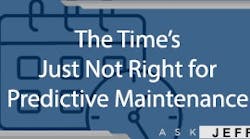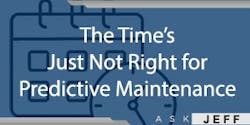Troy, plant manager, KY
Answer: Hello, Troy. Having an effective PM program is considered foundational to establishing a successful PdM program. "Effective" means that the organization has a level of maturity in its processes and practices. You understand the likely asset failure modes that the existing PM program addresses. As such, you should not be intensely reactive. It implies that you have a solid foundation in work execution (planning and scheduling) as well. When you find potential failures, you can plan, schedule, and execute the corrective repairs in a timely fashion before the asset fails. Within these organizations, craft skills and knowledge are at a higher level than in reactive groups, typically.
Here’s the logic regarding PdM programs: If you are lacking the items above and your PM program does not add much value, then why compound your misery by taking on additional work that you can’t execute well? In these environments, the PdM program quickly flames out. It’s just one more flash in the pan of reactive chaos. Lost are the investments in the PdM tools and training. The tools are left under a desk or on the storeroom shelf to gather dust.
To correct this, I propose the concept of going “forward to the basics.” Build a solid work execution program (PMs, planning, scheduling, and metrics) that will serve as a foundation to support additional initiatives. One of those later initiatives can be a solid PdM program to take your maintenance program to the next level. An advantage to a PdM program is that it will give you an earlier warning of the potential for failure. This notice allows you to develop better plans, get materials without the need for expediting, and optimize the downtime schedule for corrective work.
In specific instances, I do like to leverage very specialized PdM approaches in reactive “niche” environments. For example, rather than trying to bite off too much, I will have a third party collect and analyze data from a particular class of few critical machines – say five to 10 larger machines to start, ones that generate significant downtime losses when they crash. With this approach, there is no burden on the site personnel to learn and implement a technology.
With today’s industrial internet of things (IoT), sensors collect the data to be transmitted wirelessly every 20 seconds if needed. Some providers will mount the sensors to ensure the correct fit. Artificial intelligence bots in the software monitor for trends and alarm points. When indicated, humans may verify an out-of-normal data point, and an email will be generated with a short report to the site personnel for investigation and possible corrective action. At a modest cost, this approach provides notification to the site of impending failures than might otherwise go undetected until the asset reaches the point of failure.Do you agree? Is there a different approach you might leverage? Please share your thoughts and feedback so all can learn.
Email me at the address below, and I will respond or place your questions with my answers here.
Talk soon,
Jeff Shiver, CMRP
If you have problems in the fields of maintenance, reliability, planning and scheduling, MRO storerooms, or leadership, please contact Jeff Shiver with your question(s) here.


